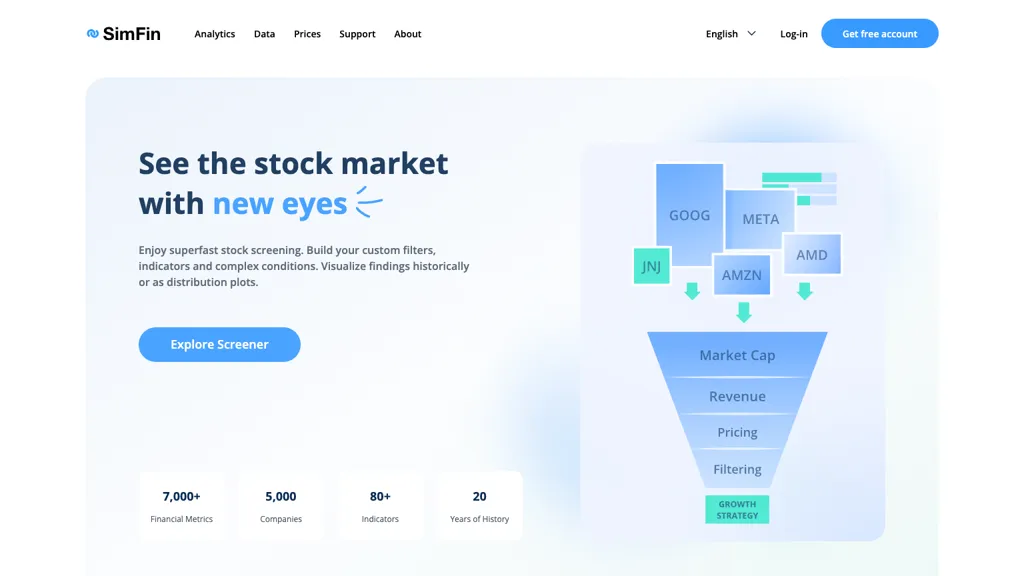20 New Facts For Picking AI Stock Trading Sites
20 New Facts For Picking AI Stock Trading Sites
Blog Article
Top 10 Ways To Evaluate The Market Coverage Provided By Ai Trading Platforms That Forecast Or Analyze Shares.
Market coverage plays a significant part in evaluating AI software for stock prediction and analysis which will determine your access to a wide array of financial markets. Platforms with a broad market coverage permit you to diversify and explore global opportunities and also adapt to various trading strategies. These are the top 10 ways to evaluate the market coverage offered by these platforms.
1. Evaluate Supported Asset Classes
Stocks: Make sure that the platform includes stocks from the top stock exchanges, which include NYSE, NASDAQ and LSE.
ETFs - See if your platform supports an extensive selection of ETFs which offer exposure to a variety of various sectors, regions, or themes.
Futures and options. Check to see whether your platform has derivatives such as futures, options or other leveraged instrument.
Forex and commodities: Determine if the platform supports forex pairs, precious-metals, energy commodities and agricultural products.
Check that the platform works with the major copyright, including Bitcoin and Ethereum, and alternative currencies.
2. Verify the coverage area
Global markets - Check that the platform is able to serve all major markets around the world which includes North America (including Canada), Europe, Asia-Pacific markets and emerging ones.
Regional focus: Find out whether the platform is focused on certain market segments or regions that are in line with your preferences for trading.
Local exchanges: Make sure you know if the platform supports regional or local exchanges that are relevant to your area or your strategy.
3. Compare real-time data with delayed Data delayed data
Real-time data - Make sure the platform provides real-time market information that will assist you in making timely decisions, especially for active traders.
Delayed information: Determine whether the delayed data is available at no cost or discounted, which could suffice for investors with an eye on the long term.
Latency of data. Check to see whether your platform reduces the latency of real-time data feeds.
4. Review historical data availability
Depth of Historical Data: Make sure the platform offers extensive historical data to backtest as well as analysis and testing (e.g. 10+ years).
Check the level of granularity in historical data.
Corporate actions: Make sure that historical data takes into consideration stock splits (if relevant) dividends, stock splits and any other corporate actions.
5. Examine the Order Book and Market Depth Data
Data Level 2: Ensure the platform has Level 2 (order book depth) to provide better price discovery.
Bid-ask Spreads: Verify that the platform displays real-time spreads between bid and request for the most precise pricing.
Volume data: Ensure that the platform has detailed data on volume for analysing liquidity and market activities.
6. Assess Coverage to determine Indices and Sectors
Major indices: Make sure that the platform includes the most important benchmarking indices that are used for index-based strategies, and other uses (e.g. S&P 500, NASDAQ 100, FTSE 100).
Data for specific industries: If you want to conduct a more specific analysis, see if there are data available for specific sectors.
Custom indices. Check if your platform allows you to create and track custom indexes based on the criteria you define.
7. Test the Integration of News and Sentiment Data
News feeds - Make sure the platform integrates live news feeds with market-moving stories from reputable (e.g. Bloomberg or Reuters) sources.
Sentiment analysis: Find out whether the platform offers tools for analyzing sentiment based on news media, social media, or other data sources.
Event-driven trades: Verify the platform's capabilities to support trading based on events (e.g. announcements on economic data or earnings announcements).
8. Look for Multimarket Trading capabilities.
Cross-markets trading: The system will allow trading on different markets or asset classes using a single user interface.
Conversion of currencies Check to see whether you are able to convert currencies in a way that is automatic for international transactions and also if you have accounts that support multi-currency transactions.
Time zone support: See if the platform accommodates trading in multiple time zones that are used for trading on global markets.
9. Examine the coverage of alternative sources
Alternative data - Look to see if there are other data sources that are integrated into the platform (e.g. web traffic, satellite imagery or transactions with credit cards). This will provide you unique insights.
ESG data - Make sure that the platform provides environmental, social, and governance information (ESG). This is essential for a an investment that is socially conscious.
Macroeconomic data - Make sure that the platform is equipped with macroeconomic data (e.g. GDP, inflation) to perform fundamental analysis.
Review customer feedback and market Reputation
User feedback is a fantastic method to assess the market reach of a platform.
Check for the platform's industry reputation. This includes recognition and awards from experts in the area.
Case studies: Look for case studies or testimonials highlighting the platform's effectiveness in specific markets or asset classes.
Bonus Tips:
Trial period: Try the demo or trial version for free to test the platform's market coverage as well as data quality.
API access - Verify whether the API can be used to gain access to data from the market in a programmatic manner.
Customer support: Check whether the platform offers support for queries related to data or markets.
Check these points to determine the market coverage offered by AI stock trading platforms. Choose a platform with access to the markets, data and tools that you need for successful trading. A broad market coverage allows you to diversify your portfolio, explore new possibilities, and adjust to market conditions that change. Take a look at the most popular do you agree about ai trade for website tips including AI stock, options ai, AI stock picker, ai investing, ai chart analysis, ai investing platform, AI stock trading bot free, AI stock trading, chatgpt copyright, incite and more.
Top 10 Tips To Evaluate The Social And Community Features Of AI stock Trading Platforms
To better know the way that users interact, learn and share, it is vital to analyze the social and community elements of AI-driven stock trading platforms. These features enhance the user experience by providing helpful assistance. Here are 10 tips for evaluating the social and community aspects of these platforms.
1. Active User Group
Tip: Look for platforms that have an extensive user base that regularly engages in discussion and provides insights and feedback.
Why? A lively user community is a vibrant ecosystem in which users can learn from each other and grow together.
2. Discussion Forums, Boards, and Discussion Forums
Tips: Check out the level of engagement and quality in discussion forums or message board.
Why? Forums allow users to ask questions, talk about strategies and market trends.
3. Social Media Integration
Tip: Check if the platform is integrated with social media channels to share insights and updates (e.g. Twitter, LinkedIn).
The reason: Social media can be used to enhance engagement and deliver actual-time market data.
4. User-Generated content
Search for features that permit you to create and share content. For instance, you can create blogs, articles, or trading strategies.
The reason: User-generated content promotes an environment of collaboration and offers many perspectives.
5. Expert Contributions
TIP: Find out if the platform features input from experts in the industry for example, market analysts or AI experts.
Expert opinion adds depth and credibility to community discussions.
6. Real-Time Messaging, Chat and Chat in Real Time
Check if there are any instant messaging or chat features that allow users to communicate instantly.
Real-time interaction allows quick exchange of information and collaboration.
7. Community Moderation and Support
Tip: Evaluate the level of support and moderating offered by the community.
Why: Effective moderation ensures an environment that is respectful and positive, while support helps resolve user concerns quickly.
8. Webinars and Events
Tip Check whether the platform hosts live Q&As with experts or hosts webinars.
The reason: These events provide the opportunity to interact directly and learning from industry professionals.
9. User Review and Comments
Look for platforms that let users post reviews or provide feedback on their community features as well as the platform.
The reason: User feedback helps to identify strengths and areas to improve.
10. Gamification and Rewards
TIP: Check whether the platform has games elements (e.g., badges, leaderboards) or rewards for active participation.
Gamification is an effective way to motivate users' involvement with the community.
Bonus Tip Security and Privacy
Use robust security and privacy measures in the social and community tools. This will protect your data and interactions.
By thoroughly assessing these aspects and evaluating these aspects, you can decide if the AI stock prediction and trading platform has a supportive and engaging community that can enhance the experience of trading and your understanding. Read the most popular https://www.inciteai.com/learn-more for website recommendations including free AI stock picker, can ai predict stock market, AI stock price prediction, best ai trading platform, best AI stocks, AI stock price prediction, AI stock price prediction, can ai predict stock market, ai for trading stocks, free ai tool for stock market india and more.